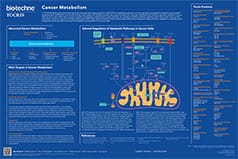mTOR
mTOR (mechanistic Target Of Rapamycin, mammalian Target Of Rapamycin) plays a key role in coordinating cell signaling pathways. mTOR is a large (>280kD), multidomain protein with a kinase domain and a FKBP12 binding domain.
mTOR Inhibitors |
|
|---|---|
| Cat. No. | 产品名称/活性 |
| 7840 | AZD 8055 |
| Highly potent and selective mTOR inhibitor | |
| 6791 | BC-LI-0186 |
| Inhibits mTORC1 activity; leucyl-tRNA synthase (TRS)/Ras-related GTP-binding protein D (RagD) interaction inhibitor | |
| 6188 | Everolimus |
| mTOR inhibitor; Immunosuppressant | |
| 3725 | KU 0063794 |
| Selective mTOR inhibitor | |
| 4079 | Niclosamide |
| STAT3 inhibitor; also inhibits mTORC1 signaling | |
| 6792 | Omipalisib |
| High affinity mTOR inhibitor; also highly potent PI 3-kinase and potent DNA-PK inhibitor | |
| 2930 | PI 103 hydrochloride |
| Inhibitor of mTOR, PI 3-kinase and DNA-PK | |
| 4257 | PP 242 |
| Dual mTORC1/mTORC2 inhibitor | |
| 1292 | Rapamycin |
| mTOR inhibitor; immunosuppressant | |
| 5264 | Temsirolimus |
| mTOR inhibitor; antitumor | |
| 4247 | Torin 1 |
| Potent and selective mTOR inhibitor | |
| 4248 | Torin 2 |
| Potent and selective mTOR inhibitor | |
| 4282 | WYE 687 dihydrochloride |
| Potent and selective mTOR inhibitor | |
mTOR (mechanistic Target Of Rapamycin, mammalian Target Of Rapamycin aka FRAP, FK506 binding protein 12 (FKBP12)-rapamycin associated protein 1) plays a key role in coordinating the signals for a number of pathways, including insulin signaling, nutrient sensing and mitogenic signaling. mTOR is a large (>280kD), multidomain protein that includes a kinase domain and a FKBP12 binding domain. Rapamycin binds to FKBP12 and then complexes with mTOR to inhibit the enzyme.
The PI 3-K pathway regulates mTOR via the tuberous sclerosis proteins, TSC1 and TSC2. These proteins activate the small GTPase Rheb, that in turn binds and activates the kinase domain of mTOR. In cells, mTOR exists as two large complexes: mTORC1 and mTORC2. mTORC1 includes several proteins, including the regulatory protein Raptor and mTORC2 includes the regulatory protein Rictor. Only mTORC1 is rapamycin sensitive. Upstream signals regulating mTORC1 include growth factors, and glucose and oxygen levels. The most widely known phosphorylation targets of mTORC1 are the key components of the protein translation machinery, 4E-BP and p70 S6 kinase 1(S6K1). A key role of mTORC2 is actin organization, although mTORC2 can phosphorylate and activate Akt. Serum glucocorticoid-induced protein kinase 1 (SGK1) has been recently identified as an mTORC2 substrate. mTORC2 is not as sensitive to nutrient levels as mTORC1, and is insensitive to rapamycin.
mTORC1 is a sensor of nutrient and growth factor levels. Consequently, it has been linked to autophagy and other metabolic pathways. mTORC1 inhibits autophagy in the presence of nutrients; under conditions such as those resulting from starvation, infection, or oxidative stress, mTORC1 is inhibited and autophagy is triggered. AMPK also inhibits mTORC1 in response to glucose deprivation. mTORC1 has also been associated with glycolysis, and sterol and lipid biosynthesis. Its regulation of SREBP-1 (sterol regulatory element binding protein 1) and HIF (hypoxia-inducible factor) is suggestive of a role for mTORC1 in cellular mechanisms balancing nutrient sensing with carbohydrate and lipid metabolism.
External sources of pharmacological information for mTOR :
Literature for mTOR
Tocris offers the following scientific literature for mTOR to showcase our products. We invite you to request* your copy today!
*Please note that Tocris will only send literature to established scientific business / institute addresses.
Cancer Metabolism Research Product Guide
This product guide reviews some of the main areas in cancer metabolism research and lists around 150 products that can be used to investigate metabolic pathways in cancer including:
- Glycolysis
- Tricarboxylic Acid Cycle
- Lipidogenesis
- 1C Metabolism and Nucleic Acid Synthesis
- Drivers of Metabolic Reprogramming
- pH and Redox Balance
Cancer Metabolism Poster
This poster summarizes the main metabolic pathways in cancer cells and highlights potential targets for cancer therapeutics. Genetic changes and epigenetic modifications in cancer cells alter the regulation of cellular metabolic pathways providing potential cancer therapeutic targets.


